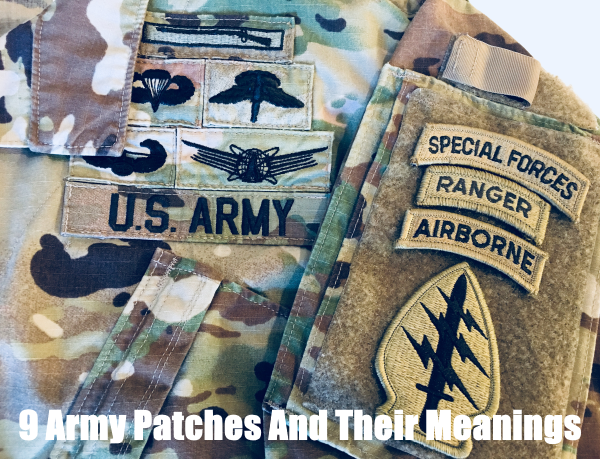What do all the Army patches on a uniform represent?
The military uniform is one of the most important items, if not the most important, a soldier possesses.
In fact, some argue the uniform is as crucial as any weapon.
The uniform not only represents your time in service but features several other distinguishing qualities.
For this reason, have you ever wondered what Army patches are on a uniform and what exactly they all mean?
Find out in our complete review of U.S. Army uniform patches and their purpose, below.
Related Article – Army Uniform Regulations
Army Uniform Patches
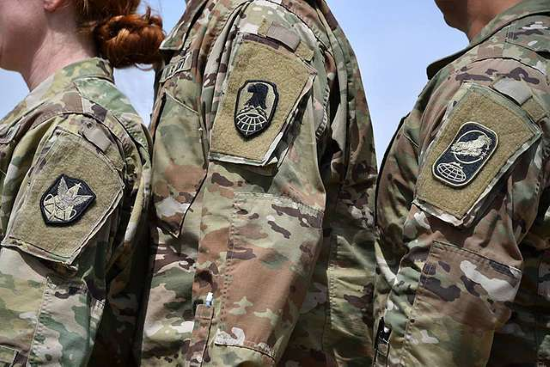
There are few honors more deserving than serving in the U.S. Armed Forces.
Military personnel are distinguished by several characteristics, including the uniform.
The military uniform is synonymous with military service.
It not only displays important information such as name, service branch, and military unit but includes lesser-known details about the soldier.
For example, Army patches also provide information relevant to the time in service, such as combat duty.
Army patches adorn a service uniform from front to back.
They exist on both shoulders and are displayed in various shapes, colors, and sizes.
History of Army Patches
Army patches didn’t become customary on military uniforms until World War I.
It’s reported that the U.S. Army 81st Infantry Division was the first unit to feature a patch for identification purposes.
The wildcat insignia became idolized by other units that desired to have their own patch for representation.
Thus, the Army transformed into the first service branch to present Shoulder Sleeve Insignia (SSI) and other patches.
Today, it’s difficult to imagine an Army uniform without the traditional patches.
Types of Army Uniforms
What exactly do all these Army patches on a military uniform mean?
First, you must understand that the U.S. Armed Forces have more than one type of military uniform.
Military uniforms include:
- Army Green Service Uniform
- Army Combat Uniform
- Service Uniform (Army Uniform Standards)
- Army PPT Uniform (Physical Fitness)
Of course, each uniform in the military has a different purpose.
Thus, for the intention of this article, we’ll address the Army patches traditionally displayed on an Army Combat Uniform (ACU).
The ACU is usually worn by Army personnel while serving on active duty or assisting combat operations.
While the U.S. Army utilizes different service uniforms, these patches are common features of combat / active-duty attire.
Therefore, you can learn what Army patches mean by 1) knowing the location/placement of the badge and 2) identifying the color, shape, or title that distinguishes what the patch means.
Below, we examine each Army patch/badge in more detail.
NOTE: Recently, the United States Army transitioned from Blues to a Green Service Uniform to honor the World War II generation.
8 Army Patches (And Their Meanings)
Army patches include basic information about the soldier (name, rank, service branch, unit, etc.) and more sophisticated details.
Below, we’ll examine the 8 most common Army patches (and 1 optional badge), including Combat and Special Skills Badges, Special Skills Tabs, and Shoulder Sleeve Insignias.
Furthermore, we’ll examine some of the biggest mysteries regarding an Army uniform, including why there is a reverse American flag patch on the shoulder.
#1. Name & Branch Tape
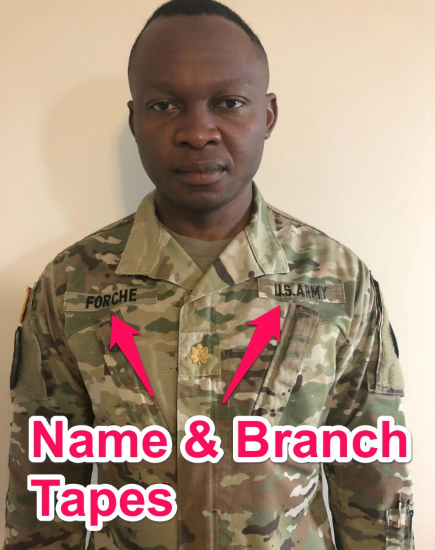
The Army Combat Uniform (ACUS) is a camouflaged combat uniform.
The military branch adopted the standard military uniform in the early 1980s.
It’s become a popular look for other service branches that model its design and badge placement on the Army presentation.
The Army Combat Uniform is designated by a Name Tape (above the right pocket) and a Branch Tape (above the front left pocket).
It informs other military personnel of the last name and service branch of the soldier.
The large capital letters make it easier for other personnel to identify in the field.
For this reason, the Branch and Name Tapes are two of the most common features of any service uniform, along with the military rank.
#2. Army Rank Patch
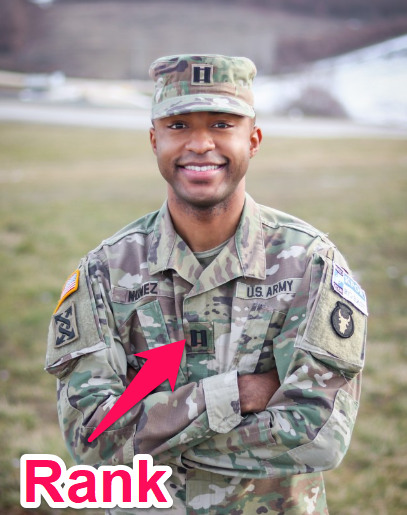
The Rank patch is another easy identifier for Army personnel.
The patch is placed directly in the middle of the chest.
It identifies the military rank of the Army soldier, ranging from E-1 (the lowest) to O-10 (the highest rank).
The only members of the Army that do not don a rank patch are new recruits still in the process of completing boot camp (otherwise referred to as Army Basic Training).
Meanwhile, the other military ranks of the U.S. Army feature specific designs associated with the rank.
You can review a complete list of all the Army patches associated with rank, here.
#3. Army Shoulder Sleeve Insignia
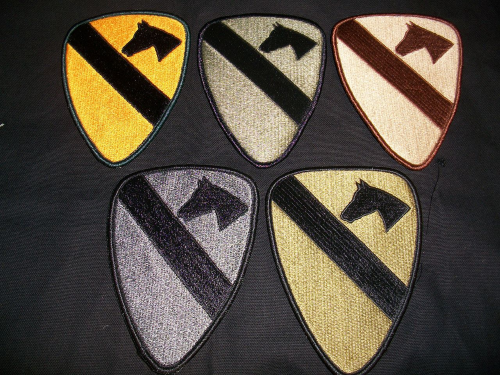
The Shoulder Sleeve Insignia exists on the left shoulder of a combat uniform.
It represents the service member’s current brigade or division, while the right shoulder displays a Combat patch.
Those that have served in multiple combat situations (and with different units) can select which unit patch they wish to display on the right shoulder.
The Combat patch is usually referred to as military operations in hostile conditions (SSI-MOHC) insignia.
Hence, the SSI-MOHC patch is generally displayed with great pride and recognition.
It means the soldier was in a combat zone and put his or her life on the line for the country.
Army patches like Combat patches are only awarded to those that served in active combat operations.
So, not every active-duty Army uniform will include SSI-MOHC patches.
#4. Army Duty Tabs
Duty Tabs exist on the left shoulder above the SSI insignia and reverse flag patch (more information, below).
These Army patches present the special skills of an individual and/or the military unit.
Individual Tabs are earned by completing a qualification course (i.e. Special Forces Army Ranger).
They are also earned through competitions like the President’s Hundred.
Meanwhile, Unit Designation Tabs identify a unit’s special skill or primary purpose.
For example, these military tabs may include insignia for Airborne or Honor Guard units.
#5. Combat Badges
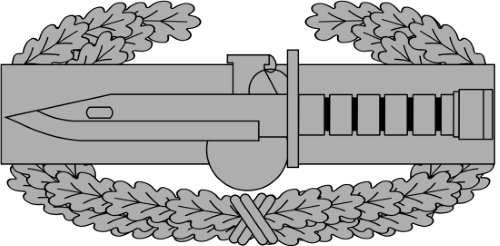
Army Combat Action Badges are comparable to Shoulder Sleeve Insignia, except the patches are not worn on the shoulders.
Rather, they appear on the left side of the chest directly above the Branch tape.
Combat Action Badges (CAB) are awarded to soldiers that are present and actively engaged in combat.
They are worn above Special Skills Badges (more details, below).
Combat Badges include special recognition, such as:
- Combat Infantryman Badge
- Combat Action Badge
- Combat Medical Badge
Army personnel are not required to serve in a combat or Special Forces role to earn a combat action badge.
#6. Special Skills Badges
Special Skills Badges are located between the Combat Action Badge and Branch Tape.
These Army patches provide information regarding the education and training of the service member.
For example, they may outline experience in an Airborne division or serving as an aviator.
Moreover, these badges are awarded to military personnel that are Rangers or Parachute jumpers.
The Army also presents special skill patches for Air Assault, Expert Field Medical, Explosive Ordnance Disposal, Pathfinder, Parachute Rigger, and Space.
#7. Army Flag Patch
Have you ever wondered why some Army uniforms feature a reverse flag patch?
A Flag Patch is worn on the right shoulder of the Army Combat Uniform.
The flag seems to be reversed to produce an effect of a flag blowing in the breeze.
It reminds the service member to always move forward in the face of adversity.
Previously, it was mandatory that the flag patch was red, white, and blue.
However, the uniform guidelines have been updated to allow muted colors (which allow the uniform to remain camouflaged).
The American flag plays a pivotal role in the military uniform.
#8. Army Identification Badge
The Army Identification Badge should not get confused with the Name and Branch Tape.
It does not identify the specific soldier.
Rather, the Army Identification Badge is insignia worn by military personnel to reflect special duties.
For example, a Drill Sergeant or Recruiter displays insignia specific to that role in the military.
In general, the identification patch is centered on the right front pocket of the uniform.
Service members may earn the award permanently after successfully completing the requirements of the special duty.
Commanders are another example of military personnel that has their own unique identification badge.
#9. Service Stripes (Optional)
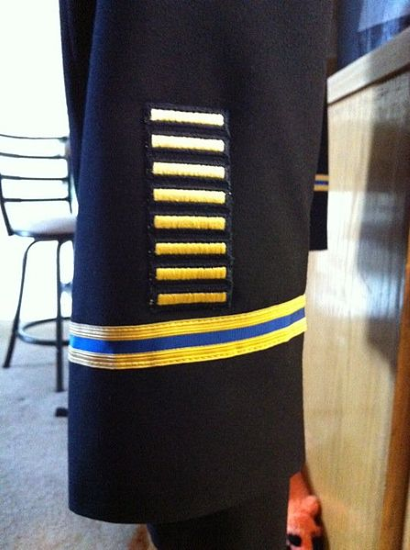
The final Army patch, albeit optional, are Service Stripes.
Service Stripes are displayed on the bottom cuff of formal uniforms.
They represent the number of years a soldier has been in the U.S. Army.
Army personnel receive a stripe for every 3 years of service.
Thus, a service member that has been in the Army for 12 years would have 4 service stripes sewn to the bottom cuff.
Army personnel earns service stripes quicker than service members in other military branches.
For example, it takes 4 years for individuals in the U.S. Navy, Coast Guard, and Marine Corps to earn their first stripe.
Meanwhile, the U.S. Air Force and recently established Space Force does not award service stripes (in any manner).
Army service stripes are worn centered on the outside bottom half of the left sleeve on the Army green uniform coat and placed at a 45-degree angle.
Army service stripes resemble a different appearance (gold with a black border) compared to other service branches (which feature their own colors for distinction).
Additionally, overseas service bars are awarded for every 6 months spent outside CONUS during specified campaigns. This insignia is worn centered on the outside bottom half of the right sleeve of the Army green uniform coat.
Conclusion
The purpose and placement of Army patches are essential.
They not only distinguish the service member but provide other relevant information regarding the soldier.
For example, Army patches may designate special skills, training, or roles in the military.
Army patches also acknowledge time in combat and become more decorated with years of service.
In general, there are 8 primary Army patches along with optional service stripes and overseas service stripes (worn with formal attire).
Featured Image Source – www.Wikipedia.org
- Replacing Dog Tags: 6 Things You Need to Know - June 28, 2024
- Navy OAR Test Study Guide - June 24, 2024
- 10 Best Sniper Movies of all Time - June 20, 2024
Originally posted on March 2, 2023 @ 10:44 pm
Affiliate Disclosure: This post may contain affiliate links. If you click and purchase, I may receive a small commission at no extra cost to you. I only recommend products I have personally vetted. Learn more.
